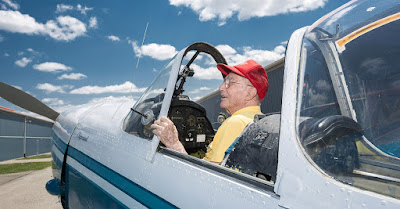Friday, 15 April 2016
World’s Oldest Active Pilot Dies
George Neal, declared as the world’s oldest active pilotby Guinness until he hung up his helmet and goggles last year, has died at the age of 97.
He passed away peacefully on April 4 in the house in North York, Ontario, in which he was born and lived all his life. “We have lost a pioneer in Canadian aviation,” said Tom Appleton, chairman of Canada’s Aviation Hall of Fame.
Neal learned to fly at the Toronto Flying Club in 1935 and earned his private certificate in 1936. From 1937 to 1941 he was employed at de Havilland Aircraft of Canada (DHC). In 1941 he enlisted in the Royal Canadian Air Force (RCAF) and was posted to No. 10 Air Observers School in Chatham, New Brunswick, where he became a flight commander, chief test pilot and assistant maintenance superintendent.
In 1946 he rejoined DHC, where he would be employed for the next 37 years. His first job was in the engine shop, and in 1947 he was transferred to the flying staff as a full-time pilot and took over the development testing of the new DHC-1 Chipmunk trainer. He became chief test pilot in 1948 and completed flight-testing of the DHC-2 Beaver, first flown by Russ Bannock, that year. Three years later he took the DHC-3 Otter aloft for the first time, and in 1958 he conducted the maiden flight of the DHC-4 Caribou.
Toward the end of the Caribou test program, during high-speed trials, a modified version developed aerodynamic flutter. After the loss of part of the tail surface, the aircraft became unmanageable, and Neal and the accompanying Department of Transport test pilot were forced to bail out. Veteran Canadian aviation enthusiast Jamie McIntyre (whose father was another prominent figure in DHC’s history) recalls: “Before exiting the front office of the Caribou, which was losing flutter-induced vertical fin skins, he took the pencils and other loose objects and returned them to their proper places; he then put on his ball cap, set up the airplane in a shallow glide, cut the engines and walked back to the exit port. Just another day at the office.” His attention to detail before bailing out prevented fire following the crash, and enabled a clear study of the cause of the flutter.
In the 1950s he procured a copy of the original drawings for the Sopwith Pup WWI fighter and built an award-winning flying replica of the aircraft, now on display at the Canada Aviation & Space Museum, at Rockcliffe Airport in Ottawa. McIntyre remembers his father selling Neal his metal lathe so he could build the Pup: “The transaction took place in Dad’s basement workshop.”
Neal accumulated 15,000 hours on 100 different aircraft types during his lifelong passion for aviation. In 1999 he was commemorated by the Royal Canadian Mint, with a $20 coin with his profile and the DHC-6 Twin Otter on the reverse and the Queen on the obverse.
Neal continued flying until last year, when he flew his personal DHC-1 Chipmunk from Brampton Airport in Toronto, for display at the 43rd Annual Induction Gala of Canada’s Aviation Hall of Fame. This flight was recorded and earned him recognition by Guinness World Records as the oldest active licensed pilot, and flying his own aircraft at 96 years and 194 days as of June 2, 2015.
Appleton recalls Neal was “a self-made man from another era with an insatiable curiosity for most things aeronautical or mechanical. Largely self taught and very much the perfectionist, George had a great respect for what was right and what was wrong, never trying to cut corners for his own or for corporate ends. George had a singular view of the test pilot’s role as the last link in the design, development and production chain of an aircraft and he made certain quality standards were met by all involved. He was ruthless with any individual, including himself, and woe betide the unsuspecting who allowed a sub-standard component to slip through the process and generate a customer complaint. ‘Good enough’ was not in George’s vocabulary, and he didn’t suffer fools gladly.
“In retirement, he once again found himself in the perfect position as chief test pilot for Canada’s National Aeronautical Museum, to which he donated the Sopwith Pup he had built, along with the ultra-rare Hawker Hind he restored. When the Museum ended its flying program in the early nineties, George returned full time to the family homestead in Downsview, now surrounded by suburbia, to work on his final labor of love–construction of a perfect Hawker Fury replica.
“Last June, watching him carefully pre-flight his Chipmunk for its final 20-minute flight in the gentle hands of its owner, at 96 years George was still the meticulous individual he had always been: a 200-rpm drop on the single magneto run-up check was sufficient to delay his first try for the Guinness world record.
“Some years earlier, Transport Canada had ‘suggested’ he have a safety pilot on board while flying, which seemed like good advice in the circumstances even though it probably chafed a little bit with him. Of course, George Neal would never think of violating their suggestion. And TC knew their man.”
(Culled from ainonline.com)
Subscribe to:
Post Comments (Atom)

No comments:
Post a Comment